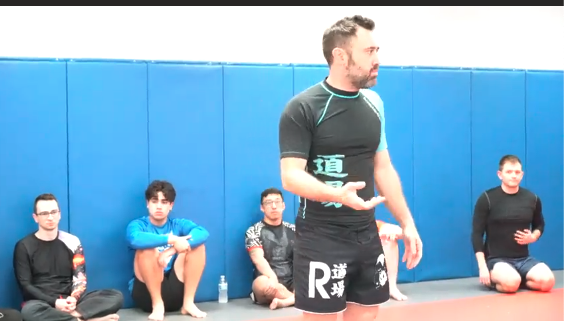Reilly Bodycomb on Principles, Mindset, and Safety in Training
Reilly Bodycomb on Principles, Mindset, and Safety in Training
Lessons from his recent seminar at 3D MMA in Hanover Park, IL
When leg lock specialist and combat sports coach Reilly Bodycomb teaches, he’s not just running through a list of techniques — he’s redefining how we think about learning, training, and staying safe on the mats.
At his recent seminar at 3D MMA in Hanover Park, Illinois, Bodycomb shared a deep look into his evolving philosophy on jiu-jitsu and grappling. His focus wasn’t on flashy submissions or the next viral move — it was on the principles that make grappling work, and the mindset that keeps athletes improving while protecting each other.
Always Recheck Your Work
Bodycomb’s approach begins with intellectual humility.
“If I realize I’m answering a question the same way I did 15 years ago, I get suspicious,” he said.
That mindset — to question, re-test, and refine — is what keeps grappling alive and evolving. Rulesets change, athletes change, and the art keeps developing. To be a great martial artist or coach, you must stay curious.
As Bodycomb put it, he’s “trying to prove himself wrong constantly.” It’s an attitude every instructor should embrace — not only to improve technically, but to keep training safer and more adaptable for everyone.
Bodycomb describes himself as a “principle-focused” coach rather than a “technique-focused” one.
“I’m looking for the heuristics — the rules of behavior in this shape. If your technique follows those rules, it’s probably correct.”
By focusing on underlying mechanics — posture, leverage, base, balance, and control — athletes can understand whysomething works rather than just what to do. This approach develops creativity, consistency, and problem-solving on the mats.
For gym owners and coaches, this is also a safety strategy: when students understand the purpose behind their movements, they train with more awareness and fewer reckless errors.
Team Mindset and Safety
One of the most powerful ideas from the seminar came when Bodycomb spoke about team culture and the responsibility each athlete has for their partner’s well-being.
“You can’t win by beating your team,” he said.
He emphasized that training should be cooperative — a shared process where both partners learn and protect each other. When someone is making a mistake, the goal isn’t to exploit it but to fix it together.
This kind of environment dramatically reduces the risk of injury and improves overall performance. As Bodycomb put it, “Safety comes from a collective.”
At JiuJitsuInsurance.com, we see this every day: gyms that prioritize teamwork and safety culture experience fewer injuries, fewer liability claims, and higher student retention.
Purposeful Sparring: “Good Guy / Bad Guy” Rounds
Reilly Bodycomb leg lock seminar in Hanover Park, IL.
Bodycomb explained that most of his sparring is structured rather than open-ended. He calls it “good guy / bad guy” sparring — where one athlete focuses on a specific task or scenario, while the partner provides realistic resistance.
“This isn’t your sparring; it’s my sparring right now — and then we’ll switch,” he said.
By controlling the purpose of each round, partners can train hard but smart — staying safe while developing specific skills. This format is especially useful for gyms that want to keep new students safe or reduce strain during higher-intensity sessions.
Ego-Free Learning
“You can’t get better by yourself,” Bodycomb reminded the group.
High-level athletes understand that longevity comes from collaboration, not competition. The best black belts aren’t the ones who “win” every roll — they’re the ones who can train day after day, year after year, without breaking themselves or their partners.
That mindset — respect, awareness, and shared improvement — is also what makes for a low-risk training environmentand a stronger business.
For Coaches and Gym Owners
If you run a martial arts school, Bodycomb’s lessons tie directly into your gym’s safety and insurance outlook:
Teach principles, not just techniques. It builds smarter, safer athletes who can adapt and protect themselves.
Create a cooperative culture. Encourage students to share knowledge, not hide “secrets.” Safety is a team effort.
Structure your sparring sessions. Purposeful drilling reduces chaos and keeps everyone learning efficiently.
Revisit your methods regularly. Just like Reilly rechecks his own work, review your training policies and risk management practices often.
At JiuJitsuInsurance.com, we specialize in helping coaches and academy owners build programs that balance competition, growth, and protection — so you can focus on what matters: developing skilled, resilient, and safe martial artists.
As the seminar wrapped up, Bodycomb smiled and said,
“That’s the end of my TED Talk.”
But the lesson will stick with everyone who was on those mats in Hanover Park — and with every coach who wants to build a better, safer, and longer-lasting training culture.
About the Author
Christopher D. Martin is the CEO of JiuJitsuInsurance.com, a specialized insurance brokerage serving martial arts academies, combat sports events, and fitness professionals nationwide. Chris is also an active Brazilian Jiu-Jitsu and MMA instructor, and a published contributor to PubMed on neck trauma and safety in grappling.
For questions about martial arts insurance or safety programs for your academy, contact Chris directly at Chris@JiuJitsuInsurance.com.


